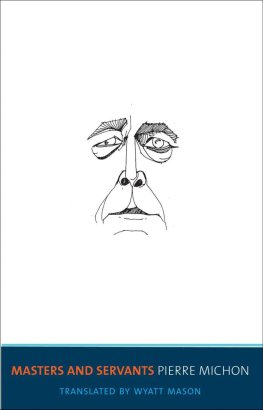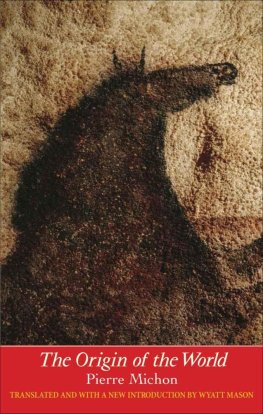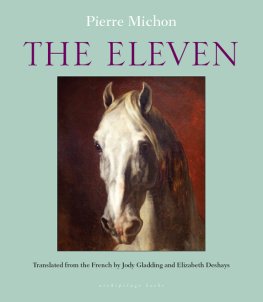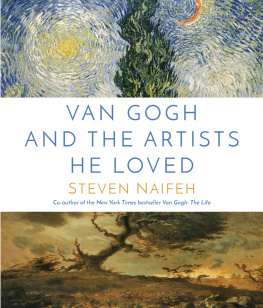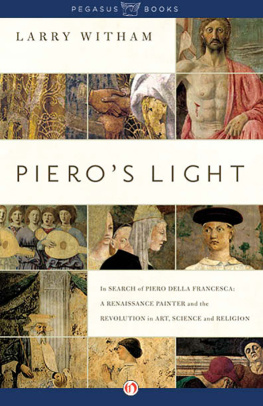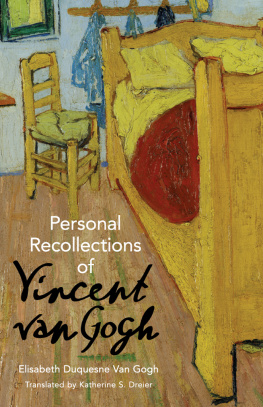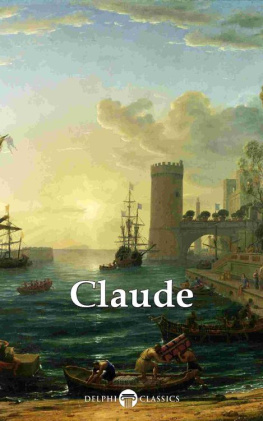Pierre Michon
Masters and Servants
Introduction by Wyatt Mason
In July 1995, when I was living in a small town in southern New Mexico, I received a letter in my post office box from Guy Davenport. Davenport was sixty-eight; I was twenty-six. He was the most learned literary person Id ever heard of: author of forty books, MacArthur fellow, poet, fiction writer, critic, the first man to write a doctoral dissertation on James Joyce at Oxford University. I was eking out a living by substitute teaching French at a high school in the sixth-poorest county in America, a school where the majority of my students spoke Spanish as their first language. Ten days beforehand, I had sent Davenport a letter; with it, I included the manuscript of a little book. I came to the little book by chance while studying in Paris in the winter of 1990. For an independent study in translation I was undertaking, I was told to pick an author who hadnt been translated into English. A twenty-year-old who had no sense of contemporary French writing, I solicited suggestions from my professors. To a one, they came back with the same name: Pierre Michon. They described him as not merely the finest contemporary French writer yet to make his way into English, but the finest living French writer a fervently held minority opinion, then as now, but not, as I would come to understand, an indefensible one. Of his five books, the criterion by which I selected the little novella I would translate, Vie de Joseph Roulin, was, I concede, sophisticated: I picked the shortest one. As it would turn out, it was also arguably the best of them, a story that following the eighteen months it took me to translate the little novels sixty-three pages I would love enough to spend the next eight years finding an American publisher for it.
Id completed the translation in June 1991, but it turned out that my not knowing a soul in the world of letters made it somewhat difficult to advance the cause of a dense novella by an obscure Frenchman. I wrote to publishing houses, unbidden. Responses came, but creepingly. Through the years, a folder slowly fattened with rejections. When verdicts arrived, many were surprisingly frank (Its kind of weird) and others frankly surprising (This guy doesnt know how to write). Nearly five years in, I had yet to receive one jot of encouraging news as a result of my mailings. Even so, I remained peculiarly sure that what I had in my hands was worth sharing.
One afternoon, after a particularly memorable morning of substitute teaching I had ridden my bicycle the five miles to work and had been caught in a desert thunderstorm that left me dripping wet upon arrival, puddles forming under my feet as I attempted to teach the subjunctive to my nineteen-year-old tenth graders I returned home where, still moist and not in the cheeriest of moods, my eyes hit upon the spine of Davenports The Geography of the Imagination: essays on writing that had often been dismissed as weird, at first the work of that James Joyce fellow, for one; and that of Kenneth Gangemi, Louis Zukovsky, Charles Olson, Paul Metcalf, and many more. It occurred to me that I should send the Michon along to Davenport. If he didnt like it, my translation wasnt any good.
What did Davenport find inside that envelope I sent him? For one thing, my cover letter: blessedly short but mercilessly overwritten. I was writing to a great man, a novel activity for me, and had attempted a great epistolary style, an adoption that by all rights should have been impeded by whatever agency oversees the elimination of the sorts of sentences that muscle, flex, groan, and grouse their way into the readers treasure box of bon mots by overworking the language sentences such as this one. (I have to hold very tightly to the edges of your letters, Davenport would write to me in later months when we had begun to correspond on other matters. Simplicity, he advised, offends no one, clarity delights all.)
Davenports reply to my overwritten plea was clear. Ive only read twenty pages of The Life of Joseph Roulin, read his typewritten response, a letter which I read in something close to shock as I crossed the railroad tracks that bordered the post office, heading down the dirt road that led to my house, but it is already sufficiently compelling that you should send it on my recommendation to the following publishers. Davenport named his publisher in New York; another in San Francisco; a third in Boston. It used to be unscrupulous to send a manuscript to more than one publisher at a time, but now its standard procedure. Anyway, publishers dont have a scruple to their name.
TWO YEARS LATER, one of the three publishers Davenport recommended to me, Mercury House, a small, now defunct press in San Francisco, issued a first edition of the book you have in your hands, a book that included and includes that novella sent to Davenport by a stranger, The Life of Joseph Roulin.
The proper name in the storys title may be familiar to you: Joseph Roulin was a postman in Arles, France, toward the end of the nineteenth century, and he and his wife and children were painted and drawn a number of times by a transplant to their town, Vincent van Gogh. These paintings now hang in museums around the world, and stories about their creation may be found in a few of the letters that van Gogh wrote to his brother, Theo, in which he mentions Roulin and his family. Beyond these paintings and those letters, there is little information about the moments the Roulins shared with the man now famous for being, as Michon puts it, the patron saint of the beaux arts.
In part, Michons novella can be seen as an enactment of Henry Jamess conception of the artistic struggle that appears in The Middle Years, his short story about a novelist: We work in the dark we do what we can we give what we have. Our doubt is our passion, and our passion is our task. The rest is the madness of art. As Davenport writes in an afterword to a collection of his own fiction, Twelve Stories, Making things is so human that psychology and philosophy have gotten nowhere in trying to account for it. Fiction, he felt, was a place for such explorations. Many of Davenports own stories seek the force invisible, ineffable that might have animated a particular maker. Tatlin!, Davenports first collection, features stories in which Edgar Allan Poe, Franz Kafka, and Vladimir Tatlin all figure. As such, and in retrospect, its easy to imagine the kinship that Davenport as an artist would have felt for Michon and his own, not dissimilar explorations. Like Davenport, Michon manages to evade one clear potential pitfall of stories about famous artists: the reductive reflex that would try to explain the source of a particular masterpiece, to solve the question of where it came from. This is emphatically not what Michons and Davenports stories seek to dramatize. Rather, both mens tales find ways of plausibly conjuring the human connections in an artists world that might have kept him alive while working in the dark. These are stories ultimately about friendship: what we give to those who make the pain to which we all are subject just another habit of being.
Pain and friendship are at the center of The Life of Joseph Roulin, as well as at the hearts of the four novellas that join it here. All of them revolve around names we know because of the images they left: Goya, in God Is Never Through; Watteau, in Io mi voglio divertir; Lorentino, an obscure disciple of Piero della Francesca, in Trust This Sign; and an unnamed follower of Claude Lorraine, in The King of the Wood. The painters here could be dancers or singers or writers: whats universal in the artistic urge is the compulsion to offer the world a masterpiece that could compete with it, and the way that compulsion can wear away at the very spirit that gives it life.

